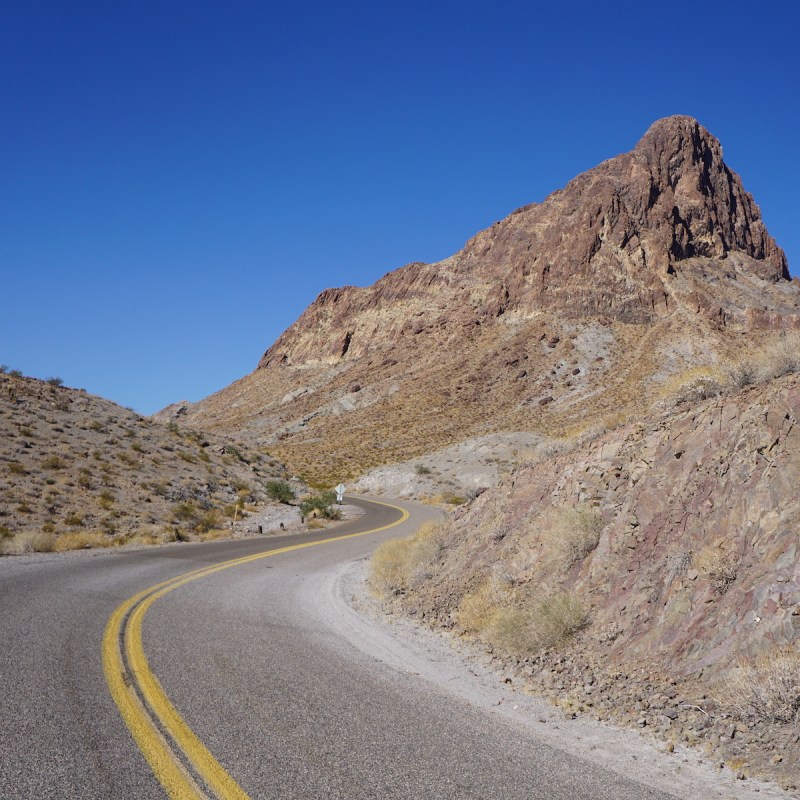
A road trip through the section of the Colorado River Corridor known as the Tri States will take travelers not just through three states, but past rugged riverside terrain, scenic state parks, a historic highway, and numerous small and mid-sized desert towns as well.
Videos by TravelAwaits
The trip from just north of Interstate 40 to Interstate 10 can be done well in 4 or 5 days. I found many interesting spots worth a stay of anywhere from a few hours to a day or two along the way.
A portion of my trip was hosted by Lake Havasu City, but all my opinions are my own.

1. Bullhead City Community Park
Bullhead City, Arizona
Located along the Colorado River at the south end of Lake Mohave, Bullhead City is a hot spot for visitors looking for virtually any type of water sports. Fishing, swimming, boating, paddle boarding, water skiing, and personal watercraft are all popular on the cool waters of the Colorado.
Bullhead City’s Community Park, with its nearly a mile of riverfront beach, is a great place to gather to beat the intense heat that the town experiences in the late spring, summer, and early fall. Because of its mild winter climate, Bullhead City annually attracts thousands of snowbirds and tourists looking for refuge from the cold weather to the north.
Pro Tip: Lake Mead National Recreation Area And Katherine Point
Bullhead City is also a convenient access point for the southern reaches of the massive Lake Mead National Recreation Area, which features the Katherine Landing full-service marina.

2. Laughlin Strip
Laughlin, Nevada
Just across the river from Bullhead City is Laughlin, a southeast-Nevada town that features eight casino resorts overlooking the Colorado River. The Laughlin Strip is a magnet for people looking for the gaming, fine dining, and varied entertainment that come with the casinos.
Laughlin is also the home of the 9-mile Colorado River Heritage Greenway Park and Trails, which offers access to beautiful and remote stretches of the Colorado River.
With its river vibe and relatively small population (about 8,000, along with Bullhead City’s 42,000 population), Laughlin is known as a more laid-back gaming alternative to the much larger city of Las Vegas to the north.
A stay of one or two nights in the Bullhead City/Laughlin area would allow visitors to enjoy the Colorado River and the casinos.

3. Big Bend Of The Colorado State Recreation Area
Laughlin, Nevada
After leaving Laughlin, I headed south on the Needles Highway on the Nevada side. Road trippers could also head south on Highway 95 on the Arizona side. I loved the Needles Highway because it passes by Nevada’s pretty Big Bend of the Colorado State Recreation Area.
The recreation area features about 2 miles of sandy shoreline and is known as a great stop for boating and fishing access as well as a place to see shore birds like mallards, coots, herons, and geese, as well as other birds like hawks, roadrunners, quail, hummingbirds, doves, and owls.
A stop of a few hours would allow for a picnic and a hike on the park’s 4 miles of trails. Or visitors could opt to camp for a night or two in the 24-unit campground that is accessible year-round.

4. El Garces Harvey House Hotel & Depot
Needles, California
Needles Highway, the Colorado River, historic Route 66, and Interstate 40 all come together in the little desert town of Needles, California. Anchoring Needles’ vintage downtown is the El Garces, a grand historic railroad hotel that was built in the early 1900s in a style suggesting a Greek temple.
Originally, the hotel was managed by the Fred Harvey Company, known as “the civilizer of the West.” Throughout the first half of the 20th century, the El Garces was a luxurious stop along the Atchison, Topeka, and Santa Fe Railroad. The Harvey House closed in 1949, and the building has been used off and on for offices since then. “Though still renovating the facility, the city plans to reopen it as a ‘Harvey House Hotel, including a Route 66 museum and shops,’” says the National Park Service website.
Today, the El Garces is a worthy stop on a road trip through Needles for a chance to walk the hotel’s massive grounds and take in the classic architecture, palm trees, and Route 66 atmosphere. A stop of several hours would allow for exploration of Needles and lunch at one of the town’s restaurants like the River Front Café or the Wagon Wheel Restaurant.

5. Wild Burros Of Oatman
Oatman, Arizona
Although Oatman is not located along the Colorado River, it is close enough to make for a quick detour. I recommend having lunch at the lively riverside Topock66 restaurant — located just off Interstate 40 and offering sweeping views of the Colorado River — and then heading north on the scenic Oatman Highway 10 to Oatman, before doubling back toward Interstate 40 to continue on to Lake Havasu City.
Oatman has a number of claims to fame, but the wild burros tend to steal the show. Burros reportedly first came to Oatman with the town’s early gold prospectors and were later released into the surrounding hills when mining operations declined. Today, burros (donkeys) freely walk the streets of Oatman, stopping traffic and delighting tourists.
Oatman is also worth a visit for its rich mining history, its place on historic Route 66, and its entertaining Old West scene. Quirky shops, restaurants, and museums line the streets.

6. London Bridge
Lake Havasu City, Arizona
By continuing onto Interstate 40 for about 22 miles and then south onto Highway 95, travelers will get to Lake Havasu City, Arizona — a Colorado River town known for being the home of the 1800s-era London Bridge, which was purchased from the city of London by an enterprising Lake Havasu City developer in the 1960s and moved to the Arizona desert.
Today’s re-created London Bridge offers a picturesque setting full of restaurants with river views, sunset cruises, and the town’s scenic Shoreline Trail. In a nod to the London Bridge and its Colorado River setting, Lake Havasu features a unique mix of British culture, Arizona desert energy, and island influences.
A stay of two or three days would allow visitors to experience the Bridgewater Channel area, take a river cruise tour, rent a boat or personal watercraft, and check out the four spectacular Arizona State Parks in the region.

7. Lake Havasu Lighthouses
Lake Havasu City, Arizona
While in Lake Havasu City, visitors should make a point of seeking out the cool network of replica lighthouses that are sprinkled all over the community. There are 28 lighthouses in all, and they are dispersed along Lake Havasu’s miles of shoreline.
The lighthouses were built as replicas of famous lighthouses along the East Coast, West Coast, and Great Lakes of the U.S. Several are located along the Shoreline Trail, while others are visible along the lake shores or accessible by hiking or by boat.

8. Buckskin Mountain State Park
Parker, Arizona
Driving the spectacular 18-mile Parker Strip is one of the pleasures of a Colorado River road trip, and along the way, visitors should be sure to get to one or all of the Arizona State Parks that are located between Lake Havasu City and Parker.
I recommend a stop at the beautiful Buckskin Mountain State Park, a spot that is known to offer some of the best views along the Strip. With mountains lining both sides of the river, the state park offers a range of hiking and waterfront camping opportunities, as well as the water sports that are available all along the corridor.
Pro Tip: Other scenic Arizona State Parks in the area include the Cattail Cove State Park, the River Island State Park, and the Lake Havasu State Park.
9. Blythe Intaglios
Blythe, California
After Parker, road trippers could choose to continue southwest for another hour or so to the Interstate 10 town of Blythe, California, via California Highway 95. There, visitors will find a desert town of about 18,000 people with a range of services and attractions.
Among the not-to-be-missed spots is the Blythe Intaglios site, described as giant figures engraved into the rocky ground, located 15 miles north of Blythe on Highway 95. “They’re one of the few unsolved mysteries of modern archaeology — pieces of history preserved in the desert on a mesa of the Big Maria Mountains north of Blythe,” says the Blythe Chamber of Commerce and Visitor Center website.
The 165-foot-long figures, now protected behind chain-link fences, show a man that is believed to be a giant hunter, likely engraved by native people thousands of years ago. The figures can be accessed by a graded dirt road but are said to be best seen by air.
Blythe is also known for its numerous boating and fishing opportunities on the Colorado River, as well as the Palo Verde Valley Historical Museum. A stay of a day would allow visitors to explore the Intaglios site and the river scene.
When To Visit The Colorado River Corridor
Late fall, winter, and early spring are the best times to visit the Colorado River Corridor. Lake Havasu City posts high temperatures in the 60-and-70-degrees Fahrenheit range in the winter, and in the 80s and 90s in the spring and fall. Summers are hot, with average highs above 100 degrees in June, July, August, and September. Other Colorado River communities have similar climates, with a few minor variations.
